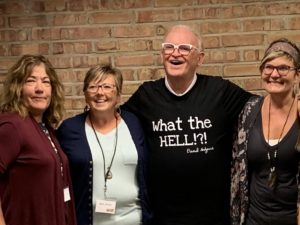Teachers come by a love of learning naturally. So when we have an opportunity to go to conferences to see leaders in the area of early childhood, we are there. I made my hotel reservations and had my registration all set up in February for this conference in Sioux Falls in August.
I have been to a conference with Denita Dinger “Defender of Play” about 4 years ago and was thrilled that Dan Hodgins was also going to attend. Along with them were two other friends of theirs, Beth Wolff and Heidi Duren, who also support play-based learning.
At this conference Dan Hodgins spoke about what makes play “PLAY”. It must be child led, child initiated, and child directed, or it is not play. We as teachers set up an environment based on our observations of the interests and development of the children we have in our class. He spoke of power struggles and how to create an environment that helps prevent them.
This is what we do at Community Preschool. Our curriculum is created by us as we get to know our students. It is based on their interests and is based on what is developmentally appropriate for the age and needs of the child. We provide opportunities for children to gain social/emotional skills as well as building large muscles so that they can gain fine motor skills.
We base our days on helping children become independent, confident, and give them tools to become social, successful human beings. We use the standards of the state of MN to provide opportunities for children to gain strength in their social/emotional/physical and (because we are in a Christian setting) their spiritual selves. We are able to say that God loves us and people are the way they are because that’s the way God made them.
Denita spoke about Intrinsic Motivation. Children need to want to do something for it to be important and last. You need JOY. We understand there is an order of learning, just like there is an order for early development. A baby learns to roll over before it learns to crawl and later walk. We need to build onto these early steps with skills that lead to the desire and ability to have “academic” success. Children learn to write when they understand the symbols mean something and they want to express something in words. Children learn about numbers and measurement when it’s something that affects them, and then the interest grows into desire to learn. If children have a strong social/emotional foundation the rest will come.
Children need “passive materials” in order to have active play. For example blocks can be many different things. The idea comes from the child. Toys that “do things” (and probably need batteries) are entertainment…they do something FOR YOU. I am always on the search for “loose parts” which are items that can be many different things or have different uses depending on who is playing with it. A bumpy bead can be used in an art project, strung on a cord, rolled in play dough to create texture, sorted, rolled, fed to a baby doll, driven in a truck, etc. etc. It’s not just a bead. The child decides what it is.
Give children respect and the right to ask for help or the time to do it themselves. As an adult, unwanted help is as frustrating to you as it can be for a child. We help them learn how to take care of themselves and their things, ie. Hanging up their backpacks and coats every day.
These are just a few takeaways I got from our conference.

